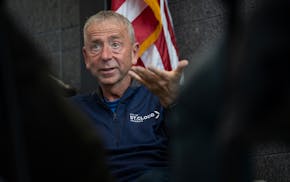In early 2004, I wrote an article for Mpls.St.Paul magazine, the purpose of which was to introduce its readers, most of whom did not use public transit, to the new Hiawatha Line, then set to open in a few weeks. My thesis (the article is archived at http://bit.ly/APlattLRT) was an unusual one in the decadeslong battles over transit modes and efficient use of public dollars.
Back then, idealistic liberals wanted more buses, as the biggest transit bang for the buck. They were focused on mobility and access. Conservatives wanted no part of light-rail transit's long-term subsidy commitment. They were opposed to building infrastructure that couldn't easily be disassembled if their anti-transit values came into the majority.
I chose not to engage either perspective. Instead I suggested that LRT would probably fail at eliminating congestion but would be wildly successful in attracting riders, because it was an amenity urbanites valued.
I pointed to successful LRT starts all over the United States. I noted that, had we not built the Hiawatha (now Blue) Line, we'd be on track to becoming the only top 25 U.S. market outside San Antonio without rail transit.
I explained that no matter how many more buses we added, a substantial subset of potential riders would not get out of their cars and use them. In North America, the bus is a stigmatized form of mobility, by and large reserved for those who have no other options.
Back in 2004, the traditional orthodoxy about rail transit was that it was a congestion-buster. I suggested that not only did the Twin Cities not suffer particularly bad congestion, but the only way to put a dent in it would be a dedicated system of lines that offered broad connectivity in speed and comfort. (Early problems with traffic-light timing on Hiawatha Avenue meant that the LRT line actually created congestion!)
Yet the Blue Line, and now the Green Line to St. Paul, quickly blew through ridership projections. Stations were lengthened to accommodate three-car trains, and riders frequently stand without seats during rush hours.
As we approach the one-year anniversary of the Green Line, with Southwest LRT mired in ever-deepening controversy and ever-spiraling costs, and with nascent Bottineau LRT already generating threats of environmental lawsuits, it seems a good moment to review what we've learned — what's worked and what hasn't in our ambivalent affair with rail.
• Desirability: LRT's success as an urban amenity has been borne out. It is undeniably successful in attracting riders. But has it attracted new riders or merely shifted bus riders to far more expensive trains?
Data from Metro Transit indicates that ridership in the Green Line corridor rose from roughly 24,000 to 39,000 weekday riders with the advent of LRT. That's 15,000 more people. At least some of those represent cars not using congested Interstate 94 or trying to park at the University of Minnesota. Metro Transit was unable to provide me with data for the Blue Line corridor, which is more difficult to measure due to a lack of parallel bus service pre-LRT.
• Development: LRT's benefits as an energizer of development — though proven in other cities — have yet to be borne out here. The theory is that the train acts as a focusing agent for commercial activity that is civilized and pedestrian-scale, and more efficient in land use and accessibility.
Hiawatha was built on the residential side of a six-to-eight-lane über-street, exactly where development normally would have gone. It was done this way because the right of way had been cleared for an unbuilt expansion of the road and it was the easiest and cheapest way to locate the train.
That left development to sprout under the hulking masses of grain elevators along the freeway-like street. Inevitably, very little has come to pass.
The lack of new residential and commercial activity along the line in Bloomington has been a greater surprise. (It's been suggested that suburbs and suburban developers have little experience with transit-oriented development and have made strategic errors in facilitating it — a question beyond the scope of this article.)
University Avenue's expanse of abandoned auto dealerships is prime territory for Green Line development, but the impoverishment of much of the adjacent neighborhood leaves me skeptical about the short-term potential for market-rate activity. The suburban-style big-box stores behind acres of garbage-strewn parking that anchor the rest of the street are evidence of St. Paul's previous lack of vision. I'm not sure who will want to relocate to look out on that day after day.
Southwest LRT would be the first line with more than a wing and prayer of development, given its proximity to large tracts of underutilized land and the corridor's affluence.
• Congestion: Despite data indicating that congestion is significant in the Twin Cities, anyone who travels to "sister" cities Denver or Seattle — both going all-in on rail transit — quickly realizes that our congestion is tepid at worst. Having multiple downtowns and a diversity of commuting patterns prevents the kind of gridlock that has motivated Denver and Seattle residents to invest in rail.
Though LRT is taking cars off the road, congestion here is unlikely to reach levels that will have residents badgering legislators for their own line as I had suggested in my article of a decade ago.
• Equity: Back a decade or two ago, nobody was talking about LRT as an "equity train." It was a congestion-reliever, a component of regional competitiveness and, like all transit, an option for those without cars.
Get on any Green or Blue Line train and you quickly see a ridership that is more diverse than the crowd in a downtown skyway or suburban office park. LRT is heavily used by those who, in the current parlance, have been shortchanged on the equity front.
Still, it is speculative at best, and intellectually dishonest at worst, to suggest that transit alone can be the solution to an urban malaise rooted in educational deficits, poverty and dubious life choices.
Yes, there are jobs in the suburbs that Southwest LRT could transport inner-city residents to. But it might be more practical for there to be affordable housing and schools near those jobs rather than viewing a mobility solution as a social-welfare program.
• Consensus: Another mistake I made a decade ago was assuming that two successful LRT starts, connecting essential magnets like the U and the airport, would build a consensus for rail that would make a system a fait accompli.
Today there is as much opposition as ever to rail transit. It's become the urban finger in the eye of exurban and rural legislators and the freakout du jour for a very connected and vocal cadre of environmentalists and NIMBYs of all stripes, who cloak themselves in intellectually empiricist arguments to seem community-minded.
I underestimated how many Twin Cities residents defined their personal quality of life by how little they had to deal with the trappings of urbanity. They don't want to hear trains; they don't want to see them, and they sure as hell don't want them near their bike trails and parks, because they've got a car and are covered.
Is there an alternative? Smart rail skeptics point to cheaper fixed busways (basically LRT lines without tracks or trains), but their rider appeal and attractiveness to development has not been borne out in a North American city like ours. It would be great to know if they're penny-wise before we jump onboard.
Some of it comes down to what kind of a region we want — one built to the whims of the automobile or a more diverse set of agendas. Car-dominated cities are ugly and inefficient, and are difficult places to live for the elderly and those with limited disposable income. Huge expanses are given over to parking, which dominates the landscape.
And there is growing evidence that the millennial generation prefers to live in places with mobility options — either due to limited means or enlightened ideals. Cities then do without rail transit at their own peril. Especially isolated cities with dreadful climates, thousands of miles from a temperate beach or snow-capped mountain, that face a net outflow of young people, as the Star Tribune recently reported the Twin Cities do.
Thus, I end up back where I started a decade ago. The Twin Cities doesn't need rail transit. It's a costly form of social engineering. But the case for LRT is more compelling if you focus on all the people riding the lines and the vibrancy and development along them that is contributing to a renaissance in our downtowns. Chicken or egg? Good question.
Would Union Station, CHS Field, and all the new restaurants and housing have come to St. Paul if the train hadn't? What might fading University Avenue descend into without LRT? And what might not have happened in downtown Minneapolis without a train every 2.5 minutes disgorging dozens of folks on 5th Street?
LRT is contributing to — if not providing the foundation for — the most thoughtful era in urban development and design the Twin Cities has seen in 100 years. It's mitigating congestion in spots — and providing a cheap trip to the airport for most of us — many times a year.
What no one truly understands is whether LRT has been the focusing agent or merely a frill. What is clear is that people sure like it. And use it. Which is what I predicted 11 years ago.
How much is that worth to you?
Adam Platt is executive editor of Twin Cities Business.

Kudos to St. Cloud's longtime mayor
Readers Write: Ethnic studies curriculum, public notice laws, student protests

